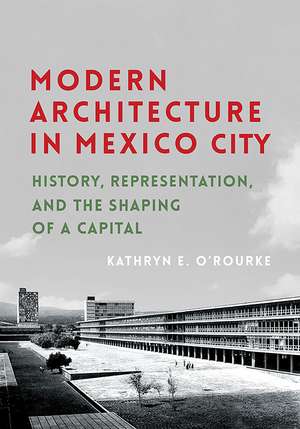Modern Architecture in Mexico City: History, Representation, and the Shaping of a Capital: Culture Politics & the Built Environment
Autor Kathryn E. O'Rourkeen Limba Engleză Paperback – 29 apr 2022
Winner, 2018 SAH Alice Davis Hitchcock Award
Mexico City became one of the centers of architectural modernism in the Americas in the first half of the twentieth century. Invigorated by insights drawn from the first published histories of Mexican colonial architecture, which suggested that Mexico possessed a distinctive architecture and culture, beginning in the 1920s a new generation of architects created profoundly visual modern buildings intended to convey Mexico’s unique cultural character. By midcentury these architects and their students had rewritten the country’s architectural history and transformed the capital into a metropolis where new buildings that evoked pre-conquest, colonial, and International Style architecture coexisted.
Through an exploration of schools, a university campus, a government ministry, a workers’ park, and houses for Diego Rivera and Luis Barragán, Kathryn O’Rourke offers a new interpretation of modern architecture in the Mexican capital, showing close links between design, evolving understandings of national architectural history, folk art, and social reform. This book demonstrates why creating a distinctively Mexican architecture captivated architects whose work was formally dissimilar, and how that concern became central to the profession.
Mexico City became one of the centers of architectural modernism in the Americas in the first half of the twentieth century. Invigorated by insights drawn from the first published histories of Mexican colonial architecture, which suggested that Mexico possessed a distinctive architecture and culture, beginning in the 1920s a new generation of architects created profoundly visual modern buildings intended to convey Mexico’s unique cultural character. By midcentury these architects and their students had rewritten the country’s architectural history and transformed the capital into a metropolis where new buildings that evoked pre-conquest, colonial, and International Style architecture coexisted.
Through an exploration of schools, a university campus, a government ministry, a workers’ park, and houses for Diego Rivera and Luis Barragán, Kathryn O’Rourke offers a new interpretation of modern architecture in the Mexican capital, showing close links between design, evolving understandings of national architectural history, folk art, and social reform. This book demonstrates why creating a distinctively Mexican architecture captivated architects whose work was formally dissimilar, and how that concern became central to the profession.
Preț: 378.66 lei
Nou
Puncte Express: 568
Preț estimativ în valută:
72.46€ • 75.81$ • 60.19£
72.46€ • 75.81$ • 60.19£
Carte disponibilă
Livrare economică 12-26 martie
Preluare comenzi: 021 569.72.76
Specificații
ISBN-13: 9780822966999
ISBN-10: 0822966999
Pagini: 432
Dimensiuni: 178 x 254 x 23 mm
Greutate: 0.98 kg
Editura: University of Pittsburgh Press
Colecția University of Pittsburgh Press
Seria Culture Politics & the Built Environment
ISBN-10: 0822966999
Pagini: 432
Dimensiuni: 178 x 254 x 23 mm
Greutate: 0.98 kg
Editura: University of Pittsburgh Press
Colecția University of Pittsburgh Press
Seria Culture Politics & the Built Environment
Recenzii
“This book could not come at a better time. It will make a valuable contribution to our understanding of the importance of architectural history within the production of modern architecture in Mexico, and it will fill a noticeable lacuna in the English language historiography of modern architecture in Latin America.”
—Luis E. Carranza, author of Modern Architecture in Latin America: Art, Technology, and Utopia
—Luis E. Carranza, author of Modern Architecture in Latin America: Art, Technology, and Utopia
“While this highly compelling text concentrates on the architectural history of a rapidly modernizing Mexico in the first half of the twentieth century, it deftly blends cogent remarks on developments within the areas of photography and even painting and sculpture to give the reader a unique insight into the monuments and personalities of this era.”
—Edward J. Sullivan, New York University
—Edward J. Sullivan, New York University
"Nonspecialists will benefit from her discussion of the role that architecture played in advancing postrevolutionary goals. . . . Also valuable are the author's discussion of English-language works on Mexican architecture that followed Baxter's work and O'Rourke's treatment of the impact on the architects of folk art and the work of artists."
—American Historical Review
—American Historical Review
Notă biografică
Kathryn E. O’Rourke is associate professor of art history at Trinity University in San Antonio.














